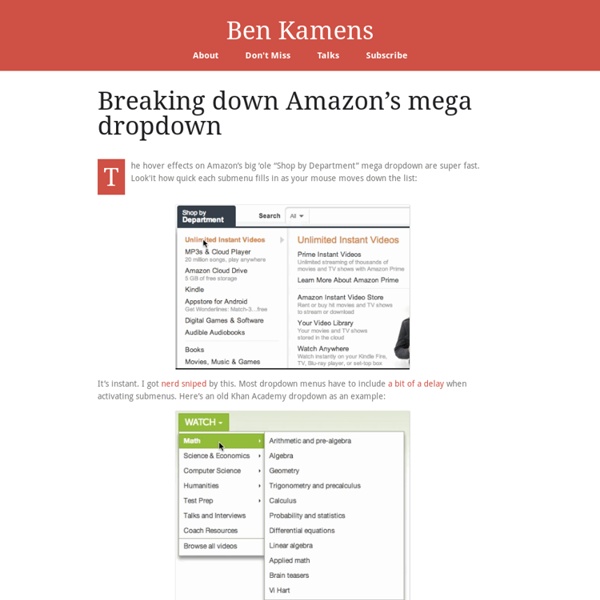Breaking down Amazon’s mega dropdown
The hover effects on Amazon’s big ‘ole “Shop by Department” mega dropdown are super fast. Look'it how quick each submenu fills in as your mouse moves down the list: It’s instant. See the delay? I love bootstrap, don’t get it twisted. It’s easy to move the cursor from Amazon’s main dropdown to its submenus. If the cursor moves into the blue triangle the currently displayed submenu will stay open for just a bit longer. At every position of the cursor you can picture a triangle between the current mouse position and the upper and lower right corners of the dropdown menu. And if the cursor goes outside of the blue triangle, they instantly switch the submenu, giving it a really responsive feel. So if you’re as geeky as me and think something this trivial is cool, I made a jQuery plugin that fires events when detecting this sort of directional menu aiming: jQuery-menu-aim. I think it feels snappy.
Showcase of Creative Navigation Menus: Good and Bad Examples
Advertisement Good navigation is the main cornerstone of an effective website. In practice, however, it’s often a tough challenge to come up with a meaningful, unambiguous way to organize, arrange, and display content to users; and it’s often not much easier to find a visually interesting solution either. The wide adaption of JavaScript libraries like jQuery is making it increasingly easy to add various kinds of sleek animations to navigation design. For instance, many recent promo websites are essentially single page websites with an array of animation effects used to make navigation a smoother and richer user experience. We need to be very careful and cautious when using these dynamic effects in our designs. Below we present some interesting examples of website navigation menus — they are not necessarily very usable, but they are certainly inspiring and original and thus you could build your designs upon the ideas presented below: use them, tweak them and improve upon them. Siebennull
Creative And Innovative Navigation Designs
Advertisement A website has a personality — it is a reflection of the person or organization behind it. When people visit your website, you want it to stand out from the crowd, to be memorable. You want people to come back and use your website or get in touch with you. So, to distinguish itself from the unwashed masses, your website not only needs remarkable content, but also has to be innovative yet functional. Creative Navigation Designs Toybox Navigation should always be there when needed, and graciously disappear when the user wants to focus on a particular task. It feels like you’re peeking behind the page or the lid of a toybox to see what’s inside. Information you might want to know, such as what Toybox does and where it is located, can still be found in a discreet navigation bar at the top. Olivier Bossel The portfolio of Olivier Bossel, an interactive designer, is interesting. Second Story Ah, good ol’ horizontal scrolling! aSCIIaRENa Calling all ASCII enthusiasts! (al)
MIT Technology Review
How the internet is making us poor
Everyone knows the story of how robots replaced humans on the factory floor. But in the broader sweep of automation versus labor, a trend with far greater significance for the middle class—in rich countries, at any rate—has been relatively overlooked: the replacement of knowledge workers with software. One reason for the neglect is that this trend is at most thirty years old, and has become apparent in economic data only in perhaps the past ten years. The first all-in-one commercial microprocessor went on sale in 1971, and like all inventions, it took decades for it to become an ecosystem of technologies pervasive and powerful enough to have a measurable impact on the way we work. This feature is Part II in a series on the rise of the machines. “Software is eating the world” Marc Andreessen is funding the companies making the software disrupting labor markets the world over. Economist Andrew McAfee, Brynjolfsson’s co-author, has called these displaced people “routine cognitive workers.”
Related:
Related:




Court à lire, technique.
"I got nerd-sniped by this" by kehrlann Mar 6